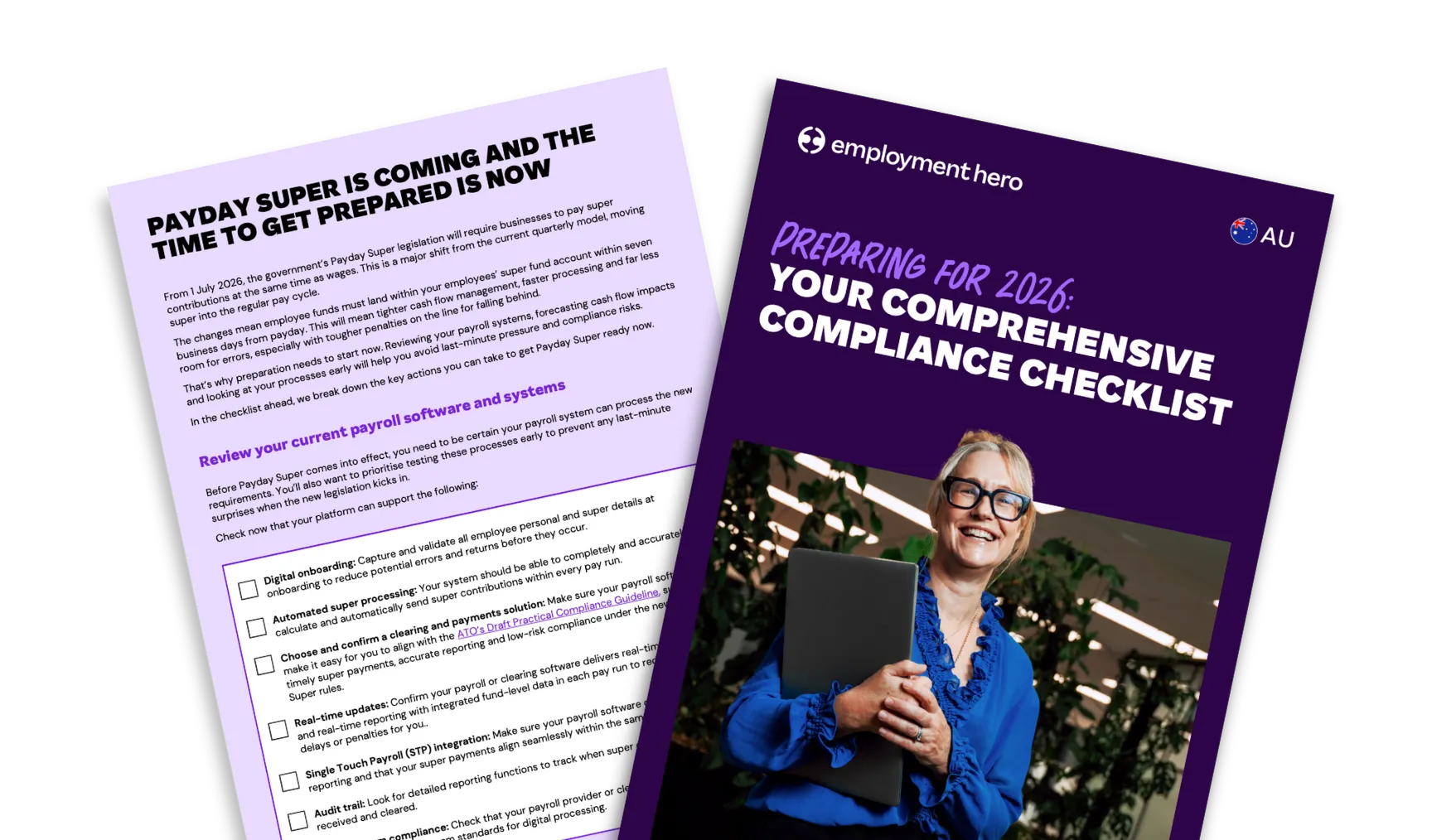
Payroll errors don’t just affect payslips; they can shake employee trust, trigger compliance headaches and expose your business to financial risk. If your payroll team is still relying on manual processes, siloed systems or a single employee, you may be overlooking critical vulnerabilities.
What is in this webinar?
With constant updates to regulations, changing workforce arrangements and evolving payroll systems, even experienced payroll professionals can find themselves stretched.
In this session, Tracy Angwin (Director, Australian Payroll Association), Slater (Special Projects Manager, Employment innovations), and Lachlan Baxter (Senior Partnerships Manager, Employment Hero) will walk you through the most common payroll risks and how to mitigate them effectively; whether you’re processing payroll in-house or managing a team across multiple systems.
In the end, you’ll walk away with:
- A practical payroll risk checklist: Learn how to identify areas of vulnerability across your payroll systems, including human errors, outdated awards, and a lack of system controls.
- A compliance confidence boost: Understand key compliance requirements and what your payroll function needs to do to stay aligned with labour laws, superannuation rules, and minimum pay rates.
- Smarter, safer processes: Discover how to build stronger governance structures, reduce dependency on a single employee, and implement robust security measures to protect sensitive data and avoid fraudulent activities.
What are common payroll risks?
In Australia, employers must comply with a mix of federal (Commonwealth) and state laws, including the Fair Work Act, Superannuation Guarantee obligations and complex tax rules, making payroll the most compliance-heavy area of your business. These frameworks are constantly evolving, and keeping up isn’t always straightforward. Non-compliance can result in significant penalties and reputational damage.
This webinar outlines the areas where payroll risks tend to show up and why it’s important to tackle them proactively rather than reactively.
Common risks with payroll processes
Payroll risks aren’t always the result of major system failures; they often arise from small gaps in everyday processes. Some of the most common process-related risks include:
- Incomplete or delayed information from other teams (e.g. HR or rostering): Payroll teams often depend on inputs like new starter details, updated contracts, approved leave, and shift data. When this information is late, incomplete or inconsistent, it puts unnecessary pressure on payroll to fill in the gaps, which increases the risk of mistakes during calculation and submission.
- Manual data entry without a clear review process: When payroll is processed manually, whether through spreadsheets or by inputting data into a system without checks, there’s a higher chance of error. Without a documented review step or dual approval process, incorrect payments can be finalised before anyone spots the issue.
- Payroll calculations based on outdated awards or contracts: Award changes, enterprise agreement updates, or changes to employment types can impact how pay should be calculated. If payroll teams aren’t alerted to these changes, or if there’s no structured way to update rules in the system, they may continue applying incorrect rates or entitlements, leaving the business open to backpay obligations or penalties.This is particularly challenging when managing independent contractors alongside employees
- No formal back-up process when a key payroll staff member is away: Many businesses still rely on one person to ‘own’ the payroll function. When that person is unavailable, knowledge gaps quickly become apparent. Without clear documentation, shared access or a back-up trained in the process, payroll continuity and accuracy are at risk.
Common risks with payroll systems
Payroll systems are central to managing compliance, accuracy and efficiency, but they’re not immune to risk. When they’re not properly configured, maintained or integrated into broader business operations, they can quietly introduce errors that impact employees and reporting obligations alike.
Some of the most common system-related risks include:
- Outdated system settings that don’t reflect recent legislation or rate changes: If your payroll system hasn’t been updated to account for changes in award rates, superannuation thresholds or tax rules, it may continue applying incorrect settings across multiple pay cycles. This can lead to underpayments, inaccurate reporting or compliance issues.
- Limited integration with HR or time-tracking systems: When payroll doesn’t connect seamlessly with other systems, such as HR platforms, rostering software or time and attendance tools, data must be entered manually or imported separately. This increases the risk of duplication, incorrect data transfer or missed updates.
- Weak user permissions and access controls: Payroll systems contain sensitive data, including salary details and bank account information. Without strong access controls in place, there’s a risk of unauthorised edits, accidental changes or data breaches. It also makes it harder to track accountability across the payroll team.
- Inaccurate or incomplete system configuration: Payroll tools are only as good as the rules they’re set up to follow. If the initial implementation didn’t capture the correct pay categories, leave accrual rates or termination conditions, then errors may be embedded in the system logic. These are often hard to spot and can persist for months.
Poor reporting or audit capabilities: Some systems lack detailed reporting functions or don’t generate audit trails that show how pay was calculated. This makes it harder to investigate discrepancies, respond to Fair Work audits or meet internal governance standards.
Struggling with outdated or disconnected systems? The right payroll software can help reduce errors, simplify compliance and bring your payroll operations into alignment. Explore how our payroll software can support your team
Tips on how to run a smooth payroll function
Running an effective payroll management process supports business compliance and keeps your employees happy (no one likes to be paid late). A well-managed payroll system prevents errors that can lead to costly mistakes and damaged trust.
So, how do you get there? Below are six practical ways to strengthen your payroll function, based on where risks most often arise.
- Establish clear documentation and approval processes to protect your payroll operations. Create simple policies that spell out payment schedules, time tracking methods, and who needs to approve what. Document exactly how to handle special cases like off-cycle payments or payment disputes so they don’t throw off your regular payroll runs. Ensure that everyone on the team understands their role, including who is responsible for approving payments, making system changes, and conducting final verification. This structured approach is crucial for preventing payroll fraud.
- Set up proper data checks before processing payments. Have team members verify employee details, look for unusual patterns in hours or payments, and check that tax codes are correct. Create reports that automatically flag concerning changes (like an employee suddenly earning 15% more without approval). Use a simple checklist for staff to complete before finalising each payroll run to catch errors before money goes out.
- Connect your HR and payroll systems to reduce manual data entry mistakes. When these systems work together, changes made in HR (like new hires, terminations, or pay adjustments) flow automatically to payroll without needing to be entered twice. For example, if someone switches from full-time to part-time in the HR system, their pay should adjust automatically in payroll. This connection creates a clear record of all changes and makes it easier to spot problems, especially when managing complex areas like fringe benefit tax calculations.
- Create a backup plan for when things go wrong. Identify weak points in your payroll process and develop simple solutions for each potential problem. Write down exactly what to do if your main system crashes, including how to calculate pay and get proper approvals. Make sure multiple team members know how to handle essential payroll tasks so you’re not dependent on any one person. Test these backup procedures regularly to make sure they actually work.
- Perform regular checks and reviews to catch issues early. Compare your payroll records against your accounting system regularly to spot any differences that need fixing. For example, match the total salary expense in payroll to what is shown in your general ledger each month. These simple reviews can prevent small problems from becoming expensive mistakes and compliance risk headaches. Consider using an income statement template to standardise this reconciliation process.
- Keep your payroll team’s knowledge up to date as rules and best practices change. Set up regular team meetings to discuss recent changes that affect your payroll processes. Provide access to webinars, online resources, and industry updates so your team stays current. A well-informed payroll team is your best defense against compliance issues and processing errors.
Ready to put these tips into action? If you’ve spotted a few cracks in your payroll function, or just want to manage risk, this webinar is for you. Join our panel of payroll experts as they share real-world insights, practical tools and lessons learned from working with businesses across Australia. You’ll walk away with clear next steps to strengthen your payroll operations and manage risk across the board.
Disclaimer: The information in this article is current as at 23 October 2023, and has been prepared by Employment Hero Pty Ltd (ABN 11 160 047 709) and its related bodies corporate (Employment Hero). The views expressed in this article are general information only, are provided in good faith to assist employers and their employees, and should not be relied on as professional advice. The Information is based on data supplied by third parties. While such data is believed to be accurate, it has not been independently verified and no warranties are given that it is complete, accurate, up to date or fit for the purpose for which it is required. Employment Hero does not accept responsibility for any inaccuracy in such data and is not liable for any loss or damages arising either directly or indirectly as a result of reliance on, use of or inability to use any information provided in this article. You should undertake your own research and to seek professional advice before making any decisions or relying on the information in this article.
Meet your hosts
Register to watch now
Related Resources
-
 Read more: HR Managers: Don’t just survive the festive season, master it
Read more: HR Managers: Don’t just survive the festive season, master itHR Managers: Don’t just survive the festive season, master it
Make year-end easier: manage leave, payroll, parties and shutdowns with confidence. Get practical tips for Australian SMEs. Download the free…
-
 Read more: Preparing for 2026: Your Compliance Checklist
Read more: Preparing for 2026: Your Compliance ChecklistPreparing for 2026: Your Compliance Checklist
Get your business ready for the 1 July 2026 changes. See practical steps for Payday Super, cash flow planning and…
-
 Read more: Monthly business budget template for employers
Read more: Monthly business budget template for employersMonthly business budget template for employers
Plan your monthly income and expenses with our free monthly business budget template. Download today to track cash flow and…


























